Involvement of prolonged ras activation in thrombopoietin-induced megakaryocytic differentiation of a human factor-dependent hematopoietic cell line
- PMID: 9632812
- PMCID: PMC109012
- DOI: 10.1128/MCB.18.7.4282
Involvement of prolonged ras activation in thrombopoietin-induced megakaryocytic differentiation of a human factor-dependent hematopoietic cell line
Abstract
Thrombopoietin (TPO) is a hematopoietic growth factor that plays fundamental roles is both megakaryopoiesis and thrombopoiesis through binding to its receptor, c-mpl. Although TPO has been shown to activate various types of intracellular signaling molecules, such as the Janus family of protein tyrosine kinases, signal transducers and activators of transcription (STATs), and ras, the precise mechanisms underlying TPO-induced proliferation and differentiation remain unknown. In an effort to clarify the mechanisms of TPO-induced proliferation and differentiation, c-mpl was introduced into F-36P, a human interleukin-3 (IL-3)-dependent erythroleukemia cell line, and the effects of TPO on the c-mpl-transfected F-36P (F-36P-mpl) cells were investigated. F-36P-mpl cells were found to proliferate and differentiate at a high rate into mature megakaryocytes in response to TPO. Dominant-negative (dn) forms of STAT1, STAT3, STAT5, and ras were inducibly expressed in F-36P-mpl cells, and their effects on TPO-induced proliferation and megakaryocytic differentiation were analyzed. Among these dn molecules, both dn ras and dn STAT5 reduced TPO- or IL-3-induced proliferation of F-36P-mpl cells by approximately 30%, and only dn ras could inhibit TPO-induced megakaryocytic differentiation. In accord with this result, overexpression of activated ras (H-rasG12V) for 5 days led to megakaryocytic differentiation of F-36P-mpl cells. In a time course analysis on H-rasG12V-induced differentiation, activation of the ras pathway for 24 to 28 h was required and sufficient to induce megakaryocytic differentiation. Consistent with this result, the treatment of F-36P-mpl cells with TPO was able to induce prolonged activation of ras for more than 24 h, whereas IL-3 had only a transient effect. These results suggest that prolonged ras activation may be involved in TPO-induced megakaryocytic differentiation.
Figures
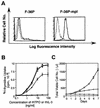
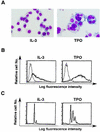

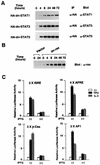


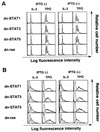
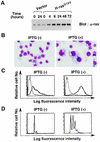
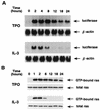

Similar articles
-
Effects of thrombopoietin, interleukin-3 and the kinase inhibitor K-252a on growth and polyploidization of the megakaryocytic cell line M-07e.Leukemia. 1998 Oct;12(10):1603-11. doi: 10.1038/sj.leu.2401170. Leukemia. 1998. PMID: 9766506
-
Establishment and characterization of the thrombopoietin-dependent megakaryocytic cell line, UT-7/TPO.Blood. 1996 Jun 1;87(11):4552-60. Blood. 1996. PMID: 8639823
-
Thrombopoietin activates a STAT5-like factor in hematopoietic cells.EMBO J. 1995 Jun 15;14(12):2847-56. doi: 10.1002/j.1460-2075.1995.tb07284.x. EMBO J. 1995. PMID: 7796811 Free PMC article.
-
Thrombopoietin induces tyrosine phosphorylation of Stat3 and Stat5 in human blood platelets.Blood. 1996 Jan 15;87(2):439-46. Blood. 1996. PMID: 8555464 Review.
-
Use of human leukemia-lymphoma cell lines in hematological research: effects of thrombopoietin on human leukemia cell lines.Hum Cell. 1996 Dec;9(4):309-16. Hum Cell. 1996. PMID: 9183663 Review.
Cited by
-
Transcriptional regulation of the cyclin D1 promoter by STAT5: its involvement in cytokine-dependent growth of hematopoietic cells.EMBO J. 1999 Mar 1;18(5):1367-77. doi: 10.1093/emboj/18.5.1367. EMBO J. 1999. PMID: 10064602 Free PMC article.
-
Role of Erk1/2 signaling in the regulation of neutrophil versus monocyte development in response to G-CSF and M-CSF.J Biol Chem. 2015 Oct 2;290(40):24561-73. doi: 10.1074/jbc.M115.668871. Epub 2015 Aug 20. J Biol Chem. 2015. PMID: 26296889 Free PMC article.
-
An ENU-induced recessive mutation in Mpl leads to thrombocytopenia with overdominance.Exp Hematol. 2009 Feb;37(2):276-84. doi: 10.1016/j.exphem.2008.10.005. Epub 2008 Dec 6. Exp Hematol. 2009. PMID: 19059699 Free PMC article.
-
Discovery of an unconventional lamprey lymphocyte lineage highlights divergent features in vertebrate adaptive immune system evolution.Nat Commun. 2024 Sep 3;15(1):7626. doi: 10.1038/s41467-024-51763-2. Nat Commun. 2024. PMID: 39227584 Free PMC article.
-
STAT5 and Oct-1 form a stable complex that modulates cyclin D1 expression.Mol Cell Biol. 2003 Dec;23(24):8934-45. doi: 10.1128/MCB.23.24.8934-8945.2003. Mol Cell Biol. 2003. PMID: 14645506 Free PMC article.
References
-
- Chiba S, Takaku F, Tange T, Shibuya K, Misawa C, Sasaki K, Miyagawa K, Yazaki Y, Hirai H. Establishment and erythroid differentiation of a cytokine-dependent human leukemia cell line F-36P: a parental line requiring granulocyte-macrophage colony-stimulating factor or interleukin-3, and a subline requiring erythropoietin. Blood. 1991;78:2261–2268. - PubMed
-
- de Rooij J, Bos J L. Minimal ras-binding domain of raf1 can be used as an activation-specific probe for ras. Oncogene. 1997;14:623–625. - PubMed
Publication types
MeSH terms
Substances
LinkOut - more resources
Full Text Sources
Research Materials
Miscellaneous
